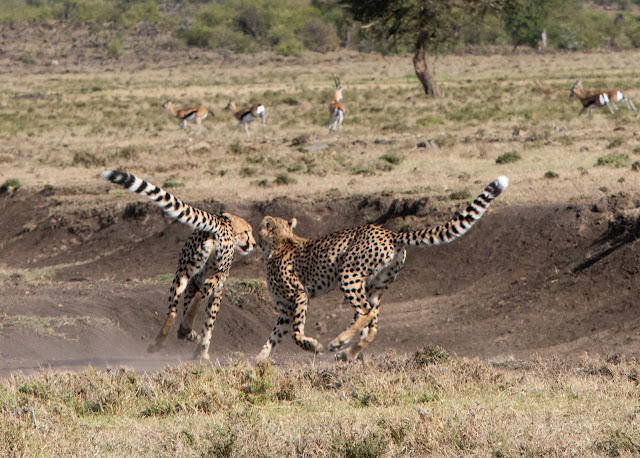Chapter 33:
In Which We See Spots and More Spots, and Save a Few
Let's get this out of the way first: I love cheetahs. I love their stealth, their grace, their speed. I love their furry cubs. I love their narrow, stream-lined bodies.
Where lions are tanks and leopards are Mack trucks, cheetahs are the Lamborghinis of the grassland savannahs.
I wish the best for cheetahs, but the odds are against them. Only about five percent of cheetah cubs make it to independence--when the mother leaves her cubs so they can strike out on their own.
So many things can go horribly wrong. Cheetahs are killed by lions, leopards, hyenas, and so on, even other cheetahs. Cubs hidden in tall grasses while the mother hunts for food are especially vulnerable.
So, keep at that in mind while I describe what happened today.
The guides locate a cheetah with three cubs resting in the shade of a tree in Naboisho Conservancy. We watch them for a long while, watch one cub climb a tree and look out at us through a crook in the trunk.
 |
| Eyes closed? Is it regretting its climb? |
Eventually, they decide to join their mother and saunter past the wildebeest.
Back at the cheetah with the younger cubs, the safari vehicles park in such a way as to block sight of them from the approaching cats. Our driver joins the line up.
Mother cheetah knows what's coming. Even though the other adult is her sister, this one knows her cubs are in danger and watches warily.
She turns and slinks away, followed by her cubs.
 |
| Maybe considering another tree climb? |
I have a notebook that I take into the field with me, mainly to jot down names of unfamiliar birds and also special events. Sometimes I make notes while we are traveling in the Land Cruisers and the results can be illegible.
The top note reads 2 lions H2O, meaning lions at the watering hole. Then, cheetah with two 10-month old cubs, and passing the gnus (wildebeest). The next two? I still haven't deciphered them, even after referring to the photos that are in chronological order.
Such is life on safari.
 |
| "UFO" refers to an unknown bird--unidentified flying object. |
For more about the fantastic five-cheetah coalition, this is a link to an article by Dr. Elena V. Chelysheva and her assistant, Jeffrey Wu Dr. Chelysheva has been studing cheetahs in the Maasai Mara for a number of years. I have had the privilege of hearing her presentations a couple times on my visits to the Mara.
/https://africageographic.com/stories/the-power-of-unity-cheetah-coalition-in-maasai-mara/
Next: I don't know yet.
.JPG)






















Another fantastic Post Gullible. We had no idea that the cheetahs are endangered (The odds are against them. Only about five percent of cheetah cubs make it to independence--when the mother leaves her cubs so they can strike out on their own). Loved the cub in the tree (photos 2 - 8) and (photo 4) sure shows what you can do with your long lens !! Amazing. Fun to see the photos showing the cubs playing. Very interesting the mother had concerns when (was it her sister) approached her and her cubs (She turns and slinks away, followed by her cubs. Loved your notes at the end, that I can really relate to. Finally the link about the coalition of the 5 males was very interesting. Next : I don't know yet. Smiles from Cap and from Patti.
ReplyDeleteHahah! Still don't know but I have three days left at that camp and then the trip home...
ReplyDelete